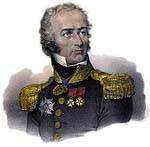Born in 1775, Maximilien-Sébastien Foy served as an artillery officer from 1792 but was suspended by the Revolutionary Tribunal for openly expressing his political views. After Thermidor, he was reinstated to his post. In 1796, he served on the Rhine and fought at Offenburg. The following year, he was wounded near Kehl. In 1799, he was given command of the artillery in Lorge's division at Zurich, and fought at Engen, Moesskirch and Biberach in 1800.
In 1803, he came out against both the consulate term being extended to life and the Empire, but was nevertheless charged with organising the coastal defence and mobile artillery, intended to offer protection to the invasion fleet at Boulogne and in the channel ports. In 1805, he was posted to the 2nd army Corps (under Marmont), and two years later, he accompanied Sébastiani on his diplomatic mission to Constantinople. By the end of 1807, he was serving under Junot in Portugal, where he was wounded in the Battle of Vimeiro. Promoted to général de brigade in November 1808, he fought under Soult against the British and General Moore at the Battle of Corunna (1809). Defeated at Porto, he was taken prisoner by the Portuguese militia before being rescued by French troops. He was made Baron de l'Empire in 1810 but was badly wounded at Bussaco. Shortly afterwards, with the army camped in front of the Lines of Torres Vedras, General Masséna dispatched him to report to Napoleon on the situation in Portugal. The bearer of bad news he may have been, but Napoleon still made him général de division. In February 1811, he returned to Portugal to take command of a division in the army's 6th Corps. He distinguished himself at the Battle of Arapiles (July 1812), where he skilfully covered the army's retreat, but he was once again wounded during the Battle of Garcia Hernandez (23 July, 1812). In 1813, he was victorious at the Battle of Maya, but was pushed back to the Nive and wounded at Orthez in February 1814.
After the French Emperor's abdication, he became inspector general of the army but returned to Napoleon's side in March 1815. During the Cent-Jours, he fought with the 2nd Corps (under Reille), most notably at Quatre-Bras (16 June, 1815) and, two days later, at Waterloo, where he received a bullet to the shoulder in the combat that raged around the Hougoumont farmstead. Excluded from all military appointments, he entered politics. He also wrote an early history of the Peninsular War. He died from a heart attack on 27 November, 1825. A courageous soldier, he was one of Napoleon's best and most respected officers.


